Combat aircraft. Best Japanese, but not Zero?
And some “specialists” and “experts” also persistently shove the A6M into all charts, regardless of who are the neighbors of the deck: fighter-bomber, deck, escort ...
But was the A6M0 and its modifications really good? Or maybe there was something better?
I believe that was. Not immediately, of course, with the course of the war. But before that I would like to say a few words about Zero.
I will not argue with those who believe that it was an outstanding car. This is really controversial, but there were already dismantling decks, the opinion remained in the same place. A6M was more than a kind of machine, so ...
So I’ll just invite you to sit in his cockpit and, in the company of such strange brothers, go towards the “Cats” and “Corsarams” from the American aircraft carriers.
You have no armor. At all. Any line from a rifle caliber machine gun to the side or rear projection - and you have problems. I am simply silent about bullets of heavy machine guns and air guns. With them, it’s even more humane immediately to the next world, without suffering.
You can hide behind only the engine in the front hemisphere, and even then conditionally. The Kinsey that you have is a copy of the Pratt-Whitney R-9 X-NUMX single-row air vent from the pre-war Hornet. With a two-row air vent it would be more reliable, but, as they say, we have what we have.
True, unlike a fellow water cooling, an air vent can give you a chance. And do not die from one or two bullets. Or maybe not.
But even if you didn’t get hit, the bullets passed, you were lucky, you should not relax. Tanks with gasoline and oil are another problem. They also have no armor. Tanks are not designed and are not filled with exhaust gases.
In general, the dream is a pyromaniac, not a plane. They will not kill, they will burn it. What to do, such is the pay for maneuverability, both horizontally and vertically. And what if the “Kinsey” from “Mitsubishi” (and “Sakai” from “Nakajima”) gave at the beginning of the war no more than 1000 hp
So the Zero had maneuverability, altitude, range and more or less decent weapons, but it was paid very dearly: with the lives of the pilots. And as soon as the pilots trained before the war began to beat out over the course of the war, things on the air front went not very beautifully.
In principle, the situation painfully recalls what I was talking about when I carefully examined the Me-109 and FW-190. And the Japanese were faced with a difficult choice - either to finally make a plane according to the European or American model, or to end up without the Air Force at all, since there will be no pilots for the planes.
Well, what if the Bushido code was unfamiliar to Americans, British and Australians, and they did not want to go ahead with cannons and machine guns, preferring to bombard enemy fighters with bullets? Fortunately, there wasn’t much to do at all.
So, "Hayat." Fighter Nakajima Ki-84.

I must say right away that the Kawasaki Ki-61 Hien will have the same review, but alas, the Japanese could not make a liquid-cooled engine. Daimler-Benz DB 601A - the engine is simply magnificent, and the Germans did everything for the Japanese to be able to produce it in their factories, but, alas, the "Japanese" Messerschmitt "did not take off. More precisely, of course, he took off and fought, but alas, his name does not turn out to be successful.
So Nakajima, in principle, won the competition for such an obvious advantage. And the aircraft in question was a kind of compromise between the predecessors of the Ki-43 Hayabusa and the Ki-44 Shoki. In general, “Hayata” was supposed to replace both aircraft, and the requirements for its performance characteristics provided for this.
On the one hand, the 84 should have maneuverability no worse (well, or not much worse) than the Ki-43, but surpass the Ki-44. And here everything is clear, “Hayabusa” is a pure fighter of gaining superiority in the air, its target was precisely enemy fighters. And “Shock” according to the Japanese classification is an interceptor of bombers.
In general, Ki-84 was originally conceived as a multi-role fighter with a large radius of action, capable of fighting both maneuverable fighters and possess sufficient firepower to destroy bombers.
The requirements provided for a maximum speed of 640-685 km / h at 5000 m, the fuel supply was supposed to allow an hour and a half to work at a distance of 400-450 km from the airfield.
Serious requirements, but in control aviation believed that the new new Nakajima Ha-18 45-cylinder radial engine rated at 2 hp able to provide the necessary power.
The armament was standard, that is, two synchronized No-103 machine guns with an 12,7-mm caliber under the hood and two No-5 cannons with an 20-mm caliber in the wings outside the circle swept by a screw.
And - lo and behold! - it was charged with providing armor protection for the pilot and equipping the vehicle with protected fuel tanks.
Work began in 1942, and at the end of 1943, the first two copies already took off.
Tests have shown that everything really worked out. And about the battle trials, it must be said that the first batches of the serial Ki-84-Ia were sent to battle to Leyte Gulf, where everything was serious and intense.

In battles, Hayat proved to be a very uncomfortable and formidable opponent. I must say that the Allied command was very puzzled by the issue of confronting the aircraft, which had very outstanding performance characteristics.
The protection of the Ki-84 compared to the standards familiar to allied pilots was simply the height of perfection. Weapon quite comparable in number, and with the quality of machine guns and guns the Japanese always had order.
An unpleasant surprise was that the Ki-84-Ia were faster and more maneuverable than all the Allied fighters, and at low and medium altitudes they were as fast as the P-51D Mustang and P-47D Thunderbolt and faster than all other Allied aircraft .
The impression was spoiled only by the fact that the prototypes and those that came out of the usual assembly shops were still different machines.

Serial Ki-84-Ia constantly suffered from defects in the fuel and hydraulic systems, frankly weak chassis struts caused some inconvenience, and Ha-45 engines rarely developed full rated power.
But the main drawback of the "Hayat" became ... the pilots! The Americans and the British, conducting tests during and after the war, noted that in the hands of an experienced pilot, the Ki-84 was a dangerous opponent. But we are talking about the events of the 1944-45 years, when it was the experienced pilots who began to disastrously end.
For 18 months of serial production, 3 473 aircraft of all modifications were built. It seems to be a little, but ... It is worth saying that almost 200 aircraft per month - this is for the Japanese industry, at the end of the war, heartily processed by American bombers, a very good indicator. I would say that they worked like real samurai.
And also modernizations were made, generally inspiring respect.

The Ki-84-Ia was followed by the Ki-84-Ib. In model “b”, the synchronized 12,7-mm machine guns were replaced by No-5 cannons with the caliber 20 mm. Thus, the armament began to consist of four 20-mm guns, two of which were synchronous, which gave a very decent level of salvo both in weight and accuracy.
But further in the series went the Ki-84-Ic model, the main task of which was the destruction of the “flying fortresses”. In this modification, the No-5 wing guns were replaced with the No-105 caliber 30 mm. Thus, the armament grew to 2x20-mm and 2x30-mm, which generally corresponded to the best indicators of the opponents.
And when the 2000-powerful Ha-45-23 engine with direct fuel injection and afterburner system, copied from the German MW-50, went into action, the speed indicators also increased to 650-670 km / h.
It was also noted the overall study of all nodes and especially the layout of the cabin. The pilot was protected by an armored head, an armored back and the visor of the lantern was made of bulletproof glass.
Progress is evident, but there was a fly in the ointment: they could not bring to mind the emergency lamp dump system, and the fire-fighting equipment remained in the pilots' dreams.
The aircraft had very good controllability, was very stable in flight, therefore it was readily used as a night interceptor. In general, the pilots loved him, because in comparison with their predecessors, it was actually a flying armored weapon platform, which made it possible to do quite a lot in combat with skillful use.
LTX Ki-84-Ia
Wingspan, m: 11,30
Length, m: 9,85
Height, m: 3.38
Wing area, м2: 21,02
Weight, kg
- empty aircraft: 2698
- normal takeoff: 3602
- Maximum takeoff: 4170
Engine Type: 1 x Ha-45-21
Power, hp: 1 x 1970
Maximum speed km / h: 687
Cruising speed, km / h: 409
Practical range, km: 2968
Fighting range, km: 1255
Max. rate of climb, m / min: 1302
Practical ceiling, m: 11582
Armament: two 20-mm guns (150 shells each), two 12,7-mm machine guns (350 cartridges for a machine gun), two 200-kg bombs.





Information